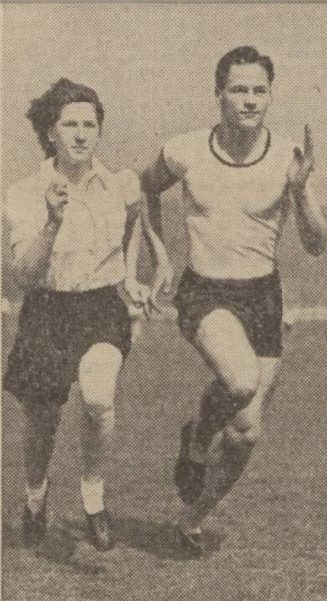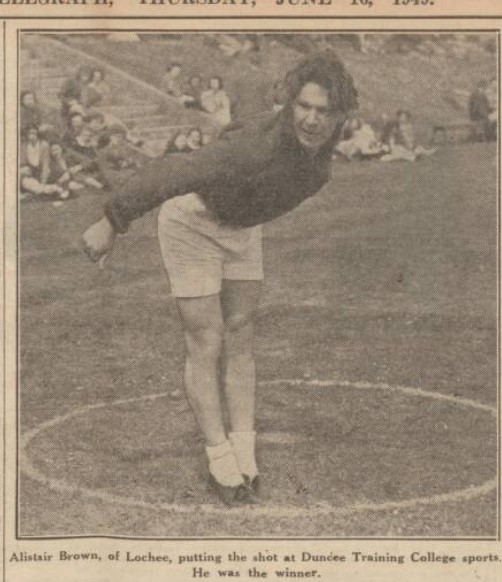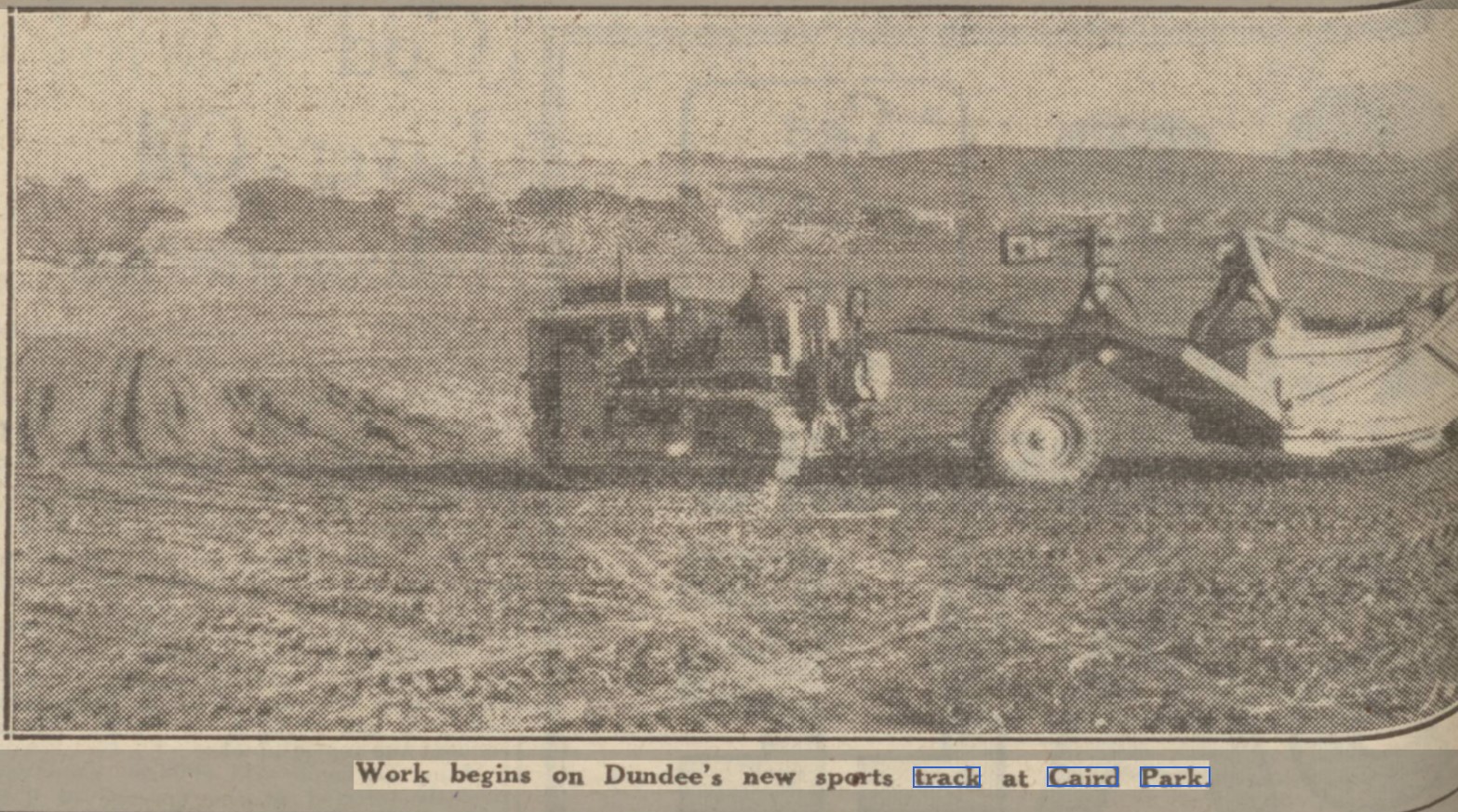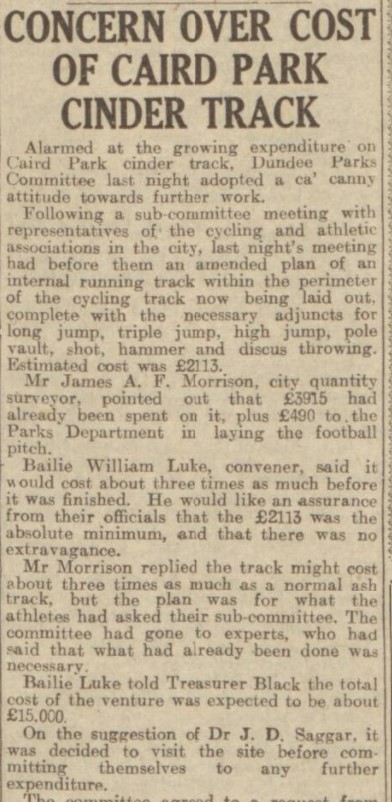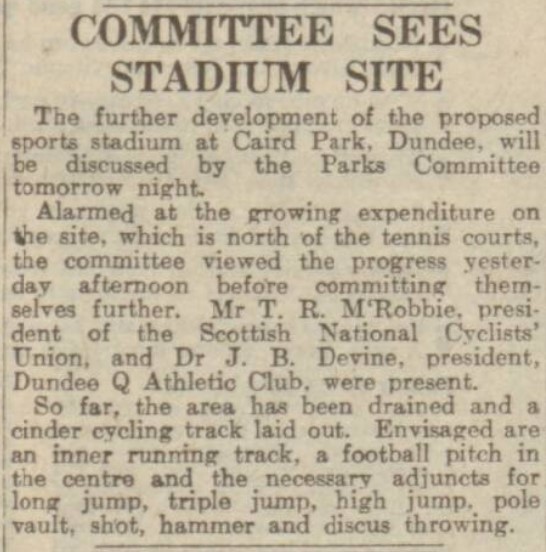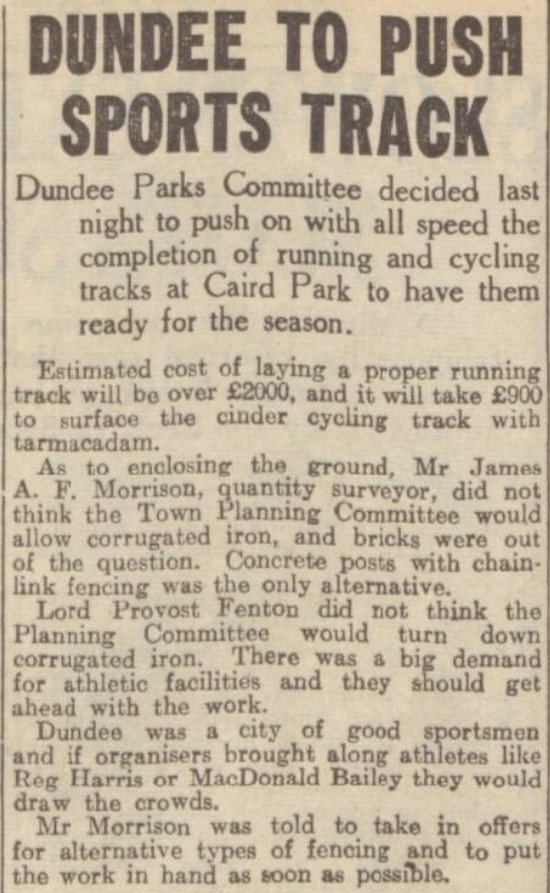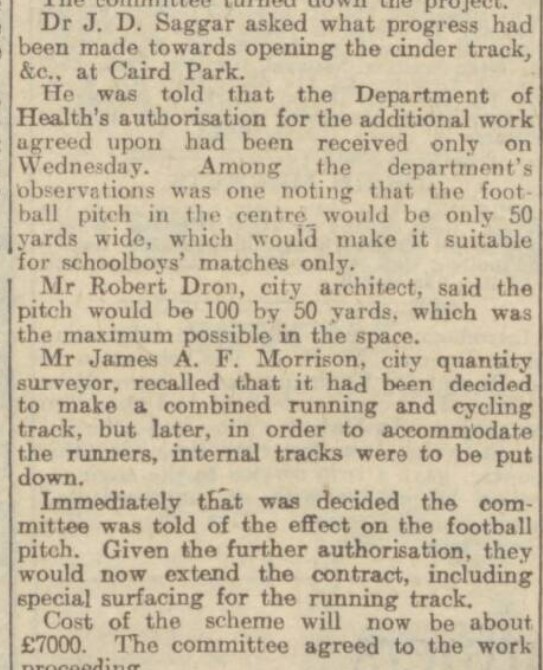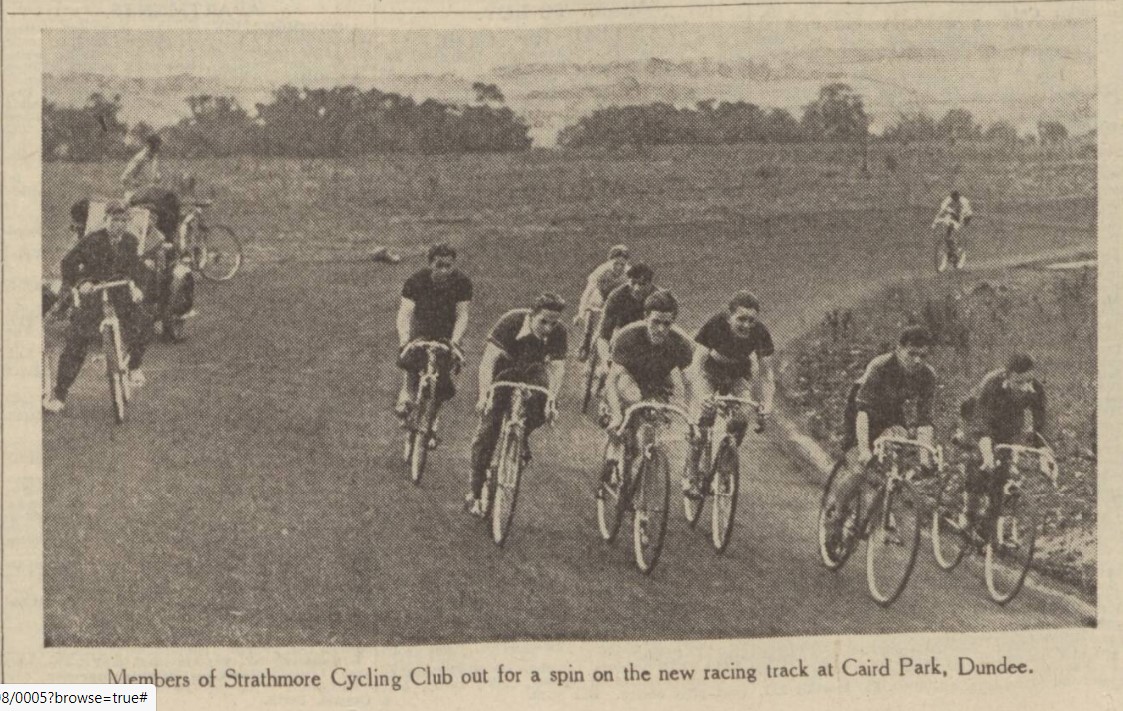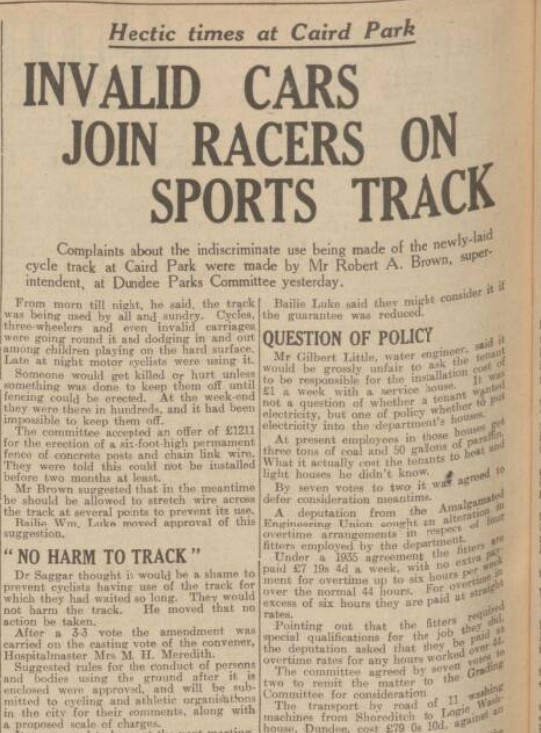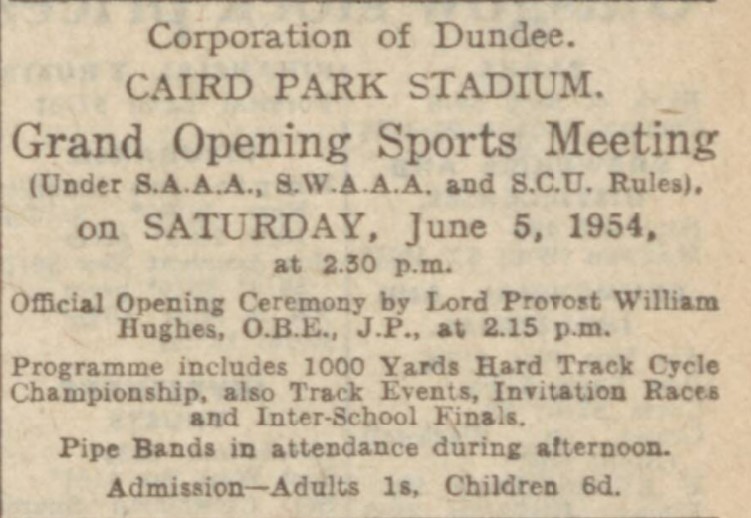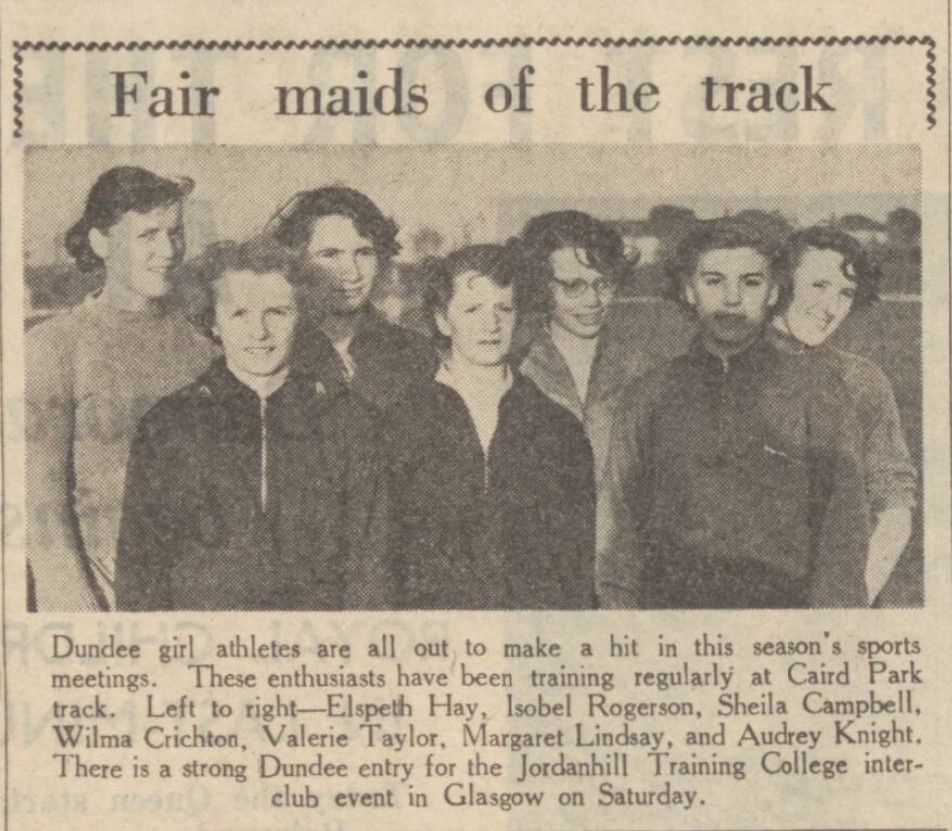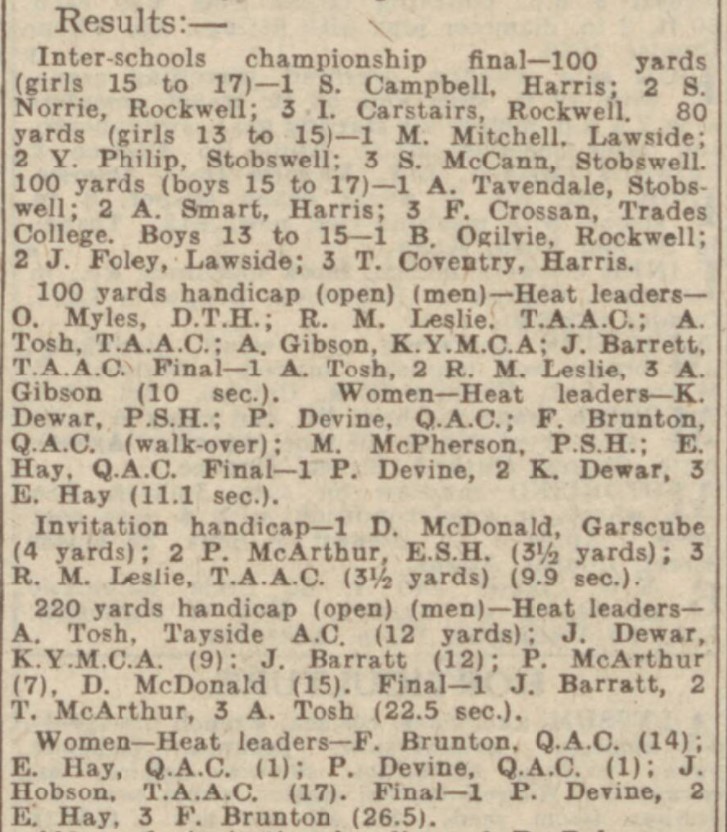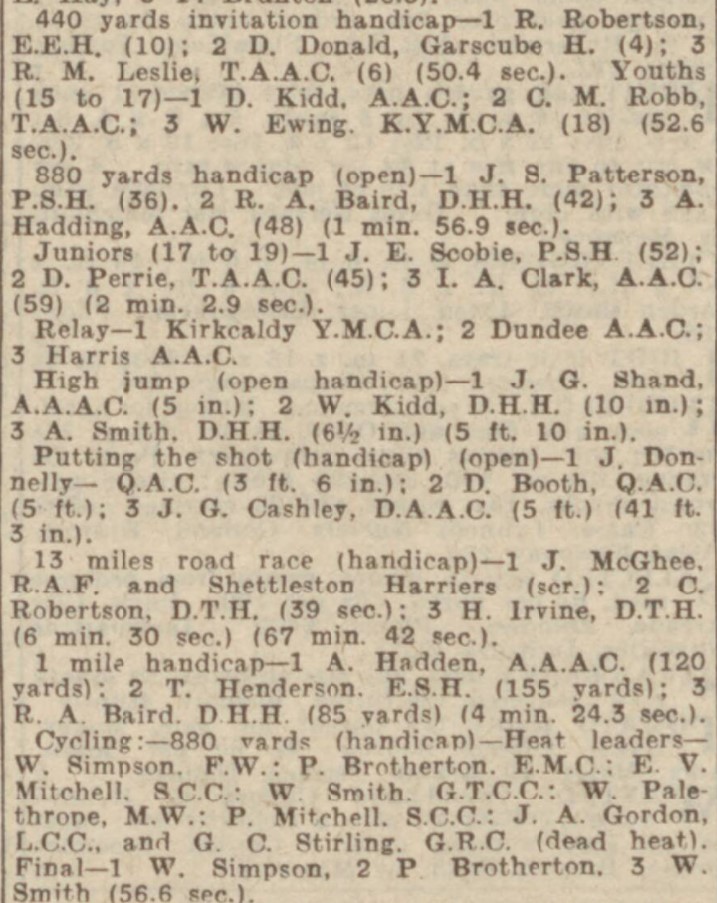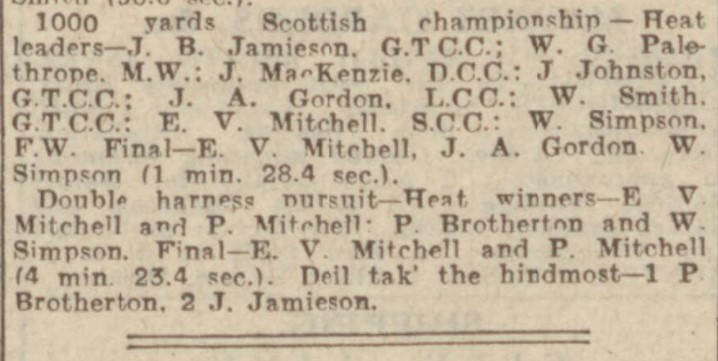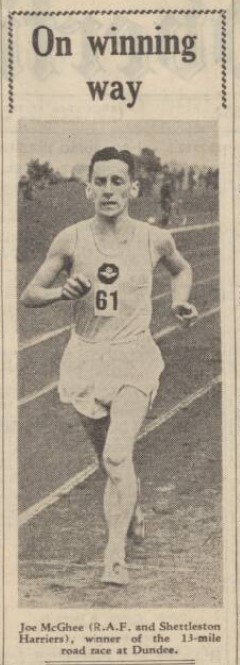Pat (16) and Brian (18) Devine training at Morgan High School, 1948
This page should be read in conjunction with the one on the Q Club
The story of the track at Caird Park starts with a quote from the ‘Courier’ –
“16-year-old Pat Devine, daughter of Dr J Bernard Devine, 22 Forfar Road, Dundee, was second in the long jump in an Olympic trial at Hampden Park, Glasgow, last night. Her jump of 16 feet 6 1/2 inches was beaten by two inches.”
Dundee courier, Saturday, 12th June, 1948
There had been talk of a cinder running track in Dundee since 1936 at least but nothing had come of it. But when young Patsy Devine of Morgan Academy showed her athletic talent in schools events and then at the Olympic Trials in Glasgow at the age of 16, her father became interested and added his voice, his drive and his talent for publicity. the campaign moved up a gear.
On 12th July that year, there was a short article in the ‘Courier’ under the headline “DUNDEE NEEDS A SPORTS GROUND” which was a quote from MP Tom Cook and read:
“”A decently equipped sports ground for Dundee was urged by Mr Tom Cook, MP, at the close of the sports and gala day in Baxter Park on Saturday. The event, organised by the Trades and Labour Council, was attended by Mr John Strachery, Minister of food who earlier had paid a visit to the Industrial Estate. Mrs Strachey presented the prizes. Mr Strachey officiated as starter for one of the races. Trophies for the 100 yards for Youths and Ladies were won by brother and sister. Brian JB Devine (18) won the ED Morel Cup and Patsy the Latto Trophy. ”
Having brought the campaign to the attention of the local MP who could be a key figurehead, the next step was to get some councillors on board and on 9th November, 1948, the following article appeared in the ‘Dundee Courier’.
Dundee Parks Committee last night sympathetically received the proposal for a cinder track for athletes training. Dr JB Devine led a deputation comprising Mr T Baptie (Union of Boys Clubs), Mr L Runcie (cyclists) and Mr R Rennie (athletes). The doctor said the request was simple it was for a 440 yard oval track to official specification for training young people of both sexes. Dundee undoubtedly had a vast reservoir of latent talent. If there was only the opportunity to develop it by proper tuition, it might go far in the sport.
“If you could see your way to grant this very humble request,” said Dr Devine, ” not only will we see to the training of young people’s bodies, but it will be helping to make good citizens. Dundee is rather unique in Scotland as we are the only big town without proper facilities for training. Glasgow, Edinburgh and Aberdeen all have fine tracks, and I am informed that even Monifieth has a track.” Dr Devine said the National Council for Physical Training was to appoint a national coach who would visit Scottish towns to coach young men in the training of athletes. It would be no use if Dundee had no place where the coach could coach his coaches.
WELCOME CROWDING
Answering questions about possible overcrowding, enclosing of the track and dressing accommodation, Dr Devine said they hoped it would be overcrowded, in which case they might have to appoint special nights for various sections. They would be very pleased just to get a track at the beginning, at Camperdown or any of the public parks. The only place not very suitable would be Riverside Park, because there was nearly always a high wind there. That would rather dampen enthusiasm. In reply to questions that children and others might not respect an unenclosed track, the doctor said that if one section of the community was anxious to do well, and it was to be penalised for an unruly or hooligan element, he was afraid it was going to be a bad social order.
Dressing rooms were almost a necessity, but if they could not be provided, that could be surmounted. The track should be eight yards wide, with about 80 yards space within the oval. A sub-committee would consider the request. The Parks Superintendant (Mr RA Brown) will report on his ideas and site suggestion, along with probable costs.”
It is almost a minute of the meeting and there was not a lot of doubt about who was driving it. The various tasks were carried out and the headline on a very brief report in the ‘Courier’ of 18th February, 1949 was “CINDER TRACK APPROVED.” The article: : “The long talked of cinder track for athletes received the approval of the Dundee Parks Committee last night.It will occupy the north east corner of Caird Park where the football pitches will be re-sited. Mr William Luke, the convener said work would be started as soon as possible.”
Nothing in local government planning ever goes smoothly and from experience I can say that the maxim holds particularly true for planning for minority sports. The ‘Evening Telegraph’ on 18th June 1949 reported “SITE CHANGED FOR RUNNING AND CYCLING TRACK”. “Dundee Parks Committee this afternoon accepted the recommendations that the proposed running and cycling track at Caird Park should be moved to a site south of the one chosen originally. The cost of levelling and preparing the latter was estimated at £14,170. Ex-Lord Provost Adamson deplored the delay in getting a running track. Quite a dew young people he said had designs on the Olympic Games in Helsinki in 1952. They were having to do their training privately.”
That there was a need for a track in Dundee there was no real doubt – there were two thriving athletic clubs in Hawkhill and the Thistle as well as several smaller clubs in and around the city as well as schools championships (individual, county and national, and athletes of talent such as the Devine runners highlighted already. The photograph below from June 1949 speaks for itself.
That was in June, 1949 and there was still no action. In February “work would begin as soon as possible” and it took until 19th September, 1950 before this headline appeared in the “Evening Telegraph’ above a lengthy article.
“Dundee sportsmen have been successful in their efforts to get a new track. A new one will be built at Caird Park. By the beginning of next summer runners and cyclists may be lapping the quarter mile cinder circuit to their hearts content. The scheme was approved by the city councillors some time ago, but was turned down by the Scottish Secretary because of financial difficulties, Now the Scottish Office have given their blessing to the scheme saying the position has recently changed following a review of the capital expenditure programme. Sports and athletic clubs have been pressing for this action for some time. When the city MP’s were in their constituencies they were interviewed and said they would make representations to the Scottish Secretary as they considered the scheme a worthy one for Dundee.
The new track will be sited near the north east corner of Caird Park opposite Morgan Academy grounds. It is being built in the centre of a hollow, and the slopes will help to form a natural amphitheatre The estimated cost was over £4000. Work is likely to start as soon as contracts can be placed. But winter is a bad season for track building, and the speed with which it can go forward depends on the weather.
“Kept Plodding Away”
A joint committee of the SAAA and the SCU was formed in 1936 to see what could be done about providing a track. Mr Dickson Hogg, District Officer of the SAAA, said today, “I am very pleased because there has been a lot of work behind the scenes . We have never lost sight of our aim. We kept plodding away and now our efforts have borne fruit. The next Olympics are in 1952and we hope to encourage local athletes if we have anyone up to Olympic standard. Elspeth Hay is outstanding in Scotland just now over the 100 yards and 100 metres and she will have all the facilities that she requires.”
Shilling Fund Not Affected
Mr Jack Qusklay, Chairman of the Dundee Civic Stadium Development Committee, said the good news would not affect the inauguration of the Shilling Fund, by which it was hoped to raise £5000. That money would be collected to ensure that the scheme went ahead in the early stages. “In the later stages of course,” said Mr Qusklay, ” almost the whole cost would fall on municipal funds, but at the moment we realise that municipal funds are very tight. For that reason, we are asking Dundee folk – Dundee folk in all parts of the world – for their help. We are sending circulars to the various Dundee Associations in Calcutta, Canada and the United States. “Our point is that we want the track available for the spring of 1951, and unless we can subsidise the preparatory work to some extent that would be impossible. We want to buttress the municipal funds with our own collected moneyso that the scheme won’t be interrupted.”
Mr Qusklay stressed that the money would be handed over unreservedly to the Town Council .”
Evening Telegraph, 20th October, 1950
The track was not ready for Spring, 1951 as Jack Qusklay had hoped and there was a short report in the ‘Courier’ of 26th January 1951 of the need for a good rugby pitch and Jack was suggesting that the infield at the track when it was complete could be a ‘switch pitch’ which could be used for rugby and football. Came |June, and in the ‘Courier’ for the 25th of the month it reported that “Sunday Work is speeding up constructionof the sports track on Caird Park, Dundee.”
However, despite the decision to go ahead, the picture of work being done and Sunday work (workers being paid double time for Sundays) things were not looking hopeful for summer 1952 and there was growing concern over the rising cost. (18/1/52below)
Reading this it is clear that Dr Devine’s simple request for a 440 yard cinder track had morphed into a 440 yard cinder track, all the field events facilities, a banked tarmac cycling track round the outside, a football pitch in the infield, possibly a switch-pitch with rugby facility) and possibly dressing rooms. The original estimate of £4000 had risen to approx £15,000. Concerned with the councillors concern, Dr Devine and T McRobbie , president of the Cyclists Union accompanied them on their site visit on 20th February, 1952. It is interesting that the doctor is not described as representing athletics but as president of the Q Club although he filled that capacity.
The council meeting took place on 22nd February and the result was favourable – the ‘Courier’ reported as follows.
The cost mentioned here was only £2000 for the track and £900 for the cycle track. There is no mention of the £15,000 estimate from January. There were letters from members of the public both for and against by readers of the Courier, some using nom-de-plumes like Pro Bono Publico. Time passed and the demands of the facility users increased and the cost started to rise again. The Committee Meeting on 17th April 1952 discussed the topic again. An interesting comment was the one by the city quantity surveyor that internal tracks would be put down “to accommodate the runners”. The initial moves had been made for a running track and everything else had been woven around that and it was the others who were being accommodatee rather than the runners. \however, the cost was now estimated to be about £7000. It had been variously £4000, £3000, £15,000 and was now £7000 and the Shilling Fund was not being spoken of any more in the ‘Courier’.
The work went on but by August there was some kind of cycle track but no cinder track for the runners. The picture below is from the ‘Courier’ of 11th August 1952 and it would be over a year before the running track was available to those who were pushing the campaign in the beginning.
The forecasts of a year or two earlier about ‘children and others’ not respecting the track was borne out when the following report appeared. [Only the first column applies to the track]. The lengths to which they would go to keep unauthorised use to a minimum are eatraordinary – wires stretched across the track is mentioned but the same councillors who objected to the cost of the facility while it was being created were happy to spend £1211 to build a fence round it. The fact is the track which they hoped to be in use in spring 1951 was still not functional in August 1952.
The ‘Courier’ of 29th June, 1953 reported on a special athletics exhibition held in Dundee Central Museum. It said:
“In my opinion, this is the finest young generation this country has ever produced.” said ex-Lord Provost JC Adamson in Dundee Central Museum last night, refuting ,the argument that all the great sportsmen were in the past. “We have great people yet,” he said, opening a special athletics exhibition arranged by the Public Libraries, Art Galleries, and Museums Committee in conjunction with the North-Eastern Athletic Coaching Committee (SAAA). The exhibition consists mainly of trophies and medals won by local athletic clubs and individuals. Mr Admason paid tribute to the city’s great sportsmen of the past who had attained their achievements with few facilities. He would press for more facilities for this generation, and instanced the need for dressing rooms at the Caird Park track. This he thought might be provided through the Sir James Caird Land Acquisition Fund. The coaching and training of young people was of the greatest importance. They had to provide counter-attractions to cinemas and dance halls. He commended the object of the association, founded last February – raising the standard of the city’s present athletes; enabling boys and girls to begin their athletics with the correct techniques and increasing the number of coaches in the district, presently six.
The representatives present from athletics bodies in the city were shown the German film of the 1936 Berlin Olympic Games which was captured by British troops at the end of the war. Mr Brian Devine, Q Club, chairman of the coaching committee presided, and Mr RC Buist, Q Club, proposed the vote of thanks.”
There was a very brief para in the ‘Courier of 8th July that year which simply read – “The sports stadium at Caird Park opened for training last night. About 50 members of athletics clubs attended. Mr Alex S Dow, sports superintendent, told a ‘Courier’ reporter “the running track was still soft in places but with plenty of rain it will soon bed down.” He is to have tents erected as temporary stripping accommodation.”
The track was now ready for training purposes approximately 4 years after the first moves were made to have such a facility in Dundee. By September the cycle track was in good enough condition to host meetings – eg Dundee Roads, Strathmore, Thistle and Forfarshire were all holding their club championships on the track. Training went on and 1954 was the first full season with the track available for training and racing. After all the work done, time spent, meetings held, money raised and spent, it was ony appropriate that there be a proper formal ceremonial opening of the track. Accordingly the public were notified on the front page of the ‘Courier’ on 8th May, 1954 as follows:
The advert above appeared in local papers, and in the ‘Scots Athlete’ and was publicised by word of mouth.The local athletes responded to the challenge and the track was well used for training. The photograoh appeared in the ‘Courier on 20th May, 1954.
Publicity for the meeting tells us that then four cycling events (half mile, 1000 yards Scottish championship, eight lap double harness pursuit race and a de’il tak’ the hindmost were being well supported by Scottish and English champions. In the athletics events, local heroines Pat Devine and Elspeth Hay would both be running as would Eileen Seeley and Margaret Taylor, Scottish girl champions. It was a 5 laps to the mile track, and at the opening meeting the prizes would be presented by world famous cyclist Beryl Burton.
The ‘Courier Report read:
“Athletes and cyclists were full of praise on Saturday for Dundee Sports Stadium’s fast tracks. Despite the cold, the crowd of over 3000 was quick also to appreciate the clockwork manner in which the meeting was run. The opening ceremony was by Lord Provost William Hughes. He reminded the gathering that the stadium was intended to be used by young people. Some 160 young people and coaches were already using the facilities. There was room for three times as many.
Saturday’s meeting lasted for three hours. Only in the final event – the De’il tak’ the hindmost’ was there a mishap. Five cyyclists piled up. All w ere treated at the infirmary, but Alexander Speed (QAC), Leven, was detained with a badly torn leg.”
Dundee had a track – fit for training and for racing; praised by competitors and spectators alike..
